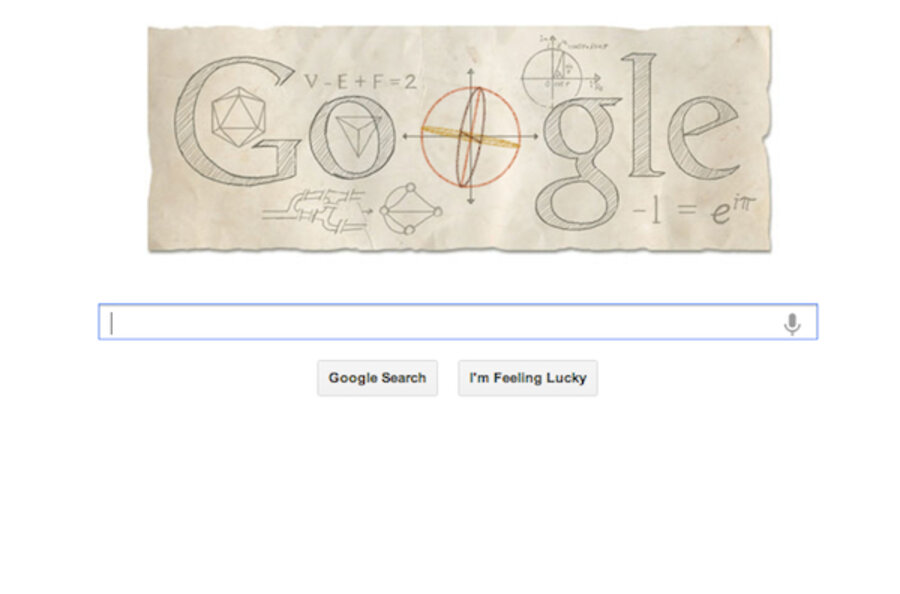Leonhard Euler: Prolific writer, pioneering mathematician, and theorist nonpareil
Loading...
The Google homepage today features a scrap of paper covered in pencil-drawn equations, including a polyhedron formula, V-E+F=2.
No, the doodle isn't a ripped-out page from a Google staffer's 11th grade math homework. Instead, it's an homage to the Swiss mathematician Leonhard Euler, who was born in the city of Basel 306 years ago today.
So who was Euler, exactly? Well, for one, he was the man responsible for the polyhedron theorem identified above. He was also the author of more than 900 works on mathematics, making him, in the words of the Guardian, "the most prolific mathematician of all time."
Euler was raised in Riehen, near Basel, by a religious family – his father, Paul Euler, was a pastor, and his mother, Marguerite Brucker, was herself the daughter of a pastor. Paul Euler had a basic understanding of mathematics, which he passed on to his son, and at the age of 14, Leonhard officially enrolled at the University of Basel.
There, the younger Euler demonstrated a preternatural grasp of math, and spent much time with Johann Bernoulli, a contemporary Swiss mathematician.
"True, he was very busy and so refused flatly to give me private lessons," Euler later wrote of Bernoulli, "but he gave me much more valuable advice to start reading more difficult mathematical books on my own and to study them as diligently as I could; if I came across some obstacle or difficulty, I was given permission to visit him freely every Sunday afternoon and he kindly explained to me everything I could not understand."
Euler's father wanted him to follow in the family tradition and become a pastor, but Bernoulli apparently helped convince Paul that his son would be much better off as a mathematician – it was clear to Bernoulli that it was math where Leonhard's true talent lay. Paul eventually relented; Leonhard graduated in 1726 and immediately began publishing mathematical papers.
In 1727, Euler set off by boat for St. Petersburg, in Russia, where he worked both as a medic in the Russian navy and as a faculty member at the St. Petersburg Academy of Sciences. In 1734, Euler married Katharina Gsell, the daughter of a Swiss painter, but by 1741, the political situation in Russia was worsening, and the couple absconded for Berlin. They remained there for a quarter of a century.
In Russia, after a particularly bad fever, Euler had begun losing his eyesight, which continued to deteriorate once Leonhard and Katharina reached Berlin.
Still, his health issues did not prevent him from producing book after book of pioneering mathematical theorems. As the Encyclopedia Britannica entry for Euler notes, from the mid-1730s until the time of his death, the Swiss was an academic juggernaut, who "enriched mathematics with substantial new concepts and techniques." Among them:
He introduced many current notations, such as Σ for the sum; ∫n for the sum of divisors of n; the symbol e for the base of natural logarithms; a, b, and c for the sides of a triangle and A, B, and C for the opposite angles; the letter “f ” and parentheses for a function; the use of the symbol π for the ratio of circumference to diameter in a circle; and i for √(-1) .
Perhaps most famously, he discovered the sequence now known as Euler Numbers, and Euler's Identity, the equation eiπ + 1 = 0. Euler's Identity is widely renowned for the way it elegantly links basic mathematical concepts.
In 1766, Euler returned to Russia, where, after a series of disasters – the loss of his house to fire, and later, the death of his wife – he passed away, in 1783. But Euler's writings remain an indelible and vitally important part of contemporary mathematics.
"Like a Shakespearean sonnet that captures the very essence of love," the 20th century British mathematician Keith J. Devlin has written of Euler's Identity, "or a painting that brings out the beauty of the human form that is far more than just skin deep, Euler's equation reaches down into the very depths of existence."
For more tech news, follow us on Twitter @venturenaut.







